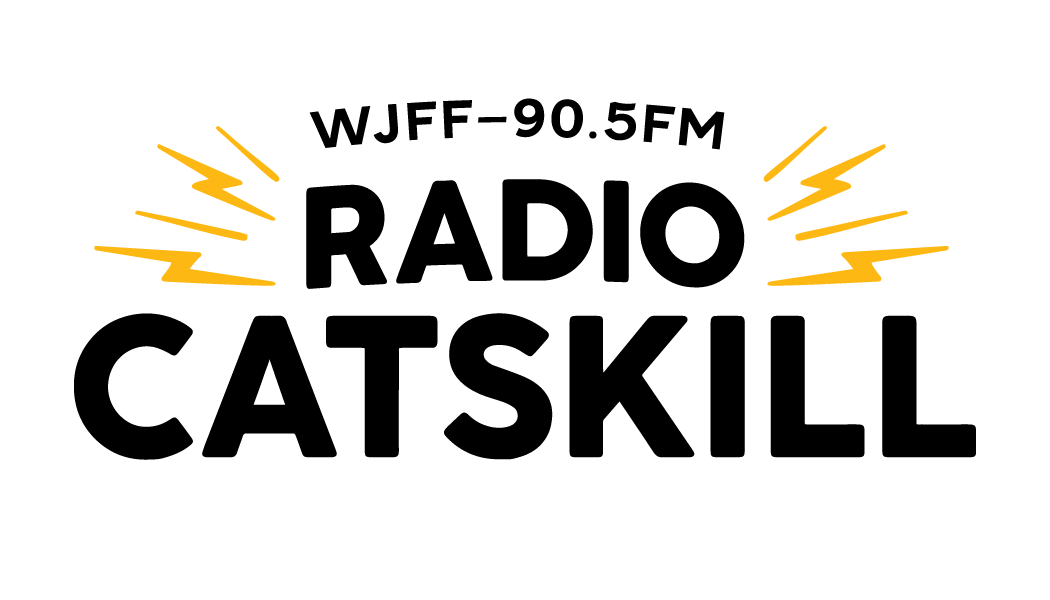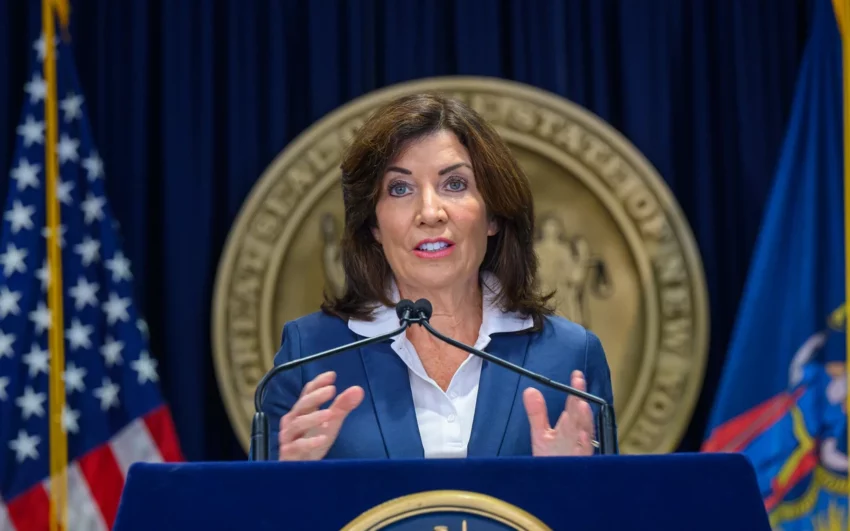This story originally appeared in New York Focus, a nonprofit news publication investigating power in New York. Sign up for their newsletter here.
NEW YORK STATE · August 9, 2024
Hochul Punts on How to Reduce Traffic and Pollution in NYC
Hochul says she’s working with the legislature to replace congestion pricing, but key legislators say they aren’t aware of any conversations.
By Sam Mellins , New York Focus
At a press conference Thursday, Governor Kathy Hochul refused to commit to achieving the reductions in air pollution and traffic that congestion pricing, which she indefinitely paused in June, was slated to produce.
Since her abrupt decision to put the years-in-the-making plan on hold punched a $15 billion hole in the budget of the Metropolitan Transportation Authority, Hochul has maintained that she will devise a replacement plan to fully fund the MTA and all of its planned upgrades and improvements.
The governor has declined to provide any details about how this will happen. And while she has suggested that she is working with the legislature to find a solution, key legislators said they aren’t aware of any active conversations between the governor and legislature on the issue.
In addition to providing funding for the MTA, congestion pricing was supposed to improve air quality and reduce record-high gridlock in downtown Manhattan and its surroundings, which are among the most congested urban areas in the world.
The tolling program would have reduced greenhouse gas emissions in downtown Manhattan by 11 percent and traffic by 17 percent, according to an MTA study.
Asked by New York Focus if she is still dedicated to meeting those metrics, Hochul merely stated that she is “committed to ensuring that there are benefits for the people who live in those areas.”
She then pivoted to the cost of congestion pricing for car owners in the Central Business District, the area of Manhattan below 60th street where the toll would have applied.
“Actually, people live in those areas who would have to pay an additional $15 to travel in and out of their own homes. That is an extraordinary cost,” she said.
Eighty percent of Central Business District residents live in households that do not own cars, according to the U.S. census.
State Senator Liz Krueger, who represents part of the Central Business District, said that Hochul declining to commit to congestion pricing’s planned environmental and traffic benefits is a “major concern.”
“Until now, she’s kept saying that we’re going to come up with an alternative that addresses those issues,” said Krueger, who has been a vocal critic of the pause.
Assemblymember Tony Simone, who also represents part of the Central Business District, sharply criticized Hochul’s statement.
“The governor has created a situation in which traffic and air quality conditions continue to worsen, and offers no solution to these crises,” he said. “Meanwhile, she is digging under the couch cushions for pennies for the MTA.”
Traffic accidents have killed far more people than gun violence in New York City so far this year, Gothamist reported in June.

New York Focus also asked Hochul why the $15 toll would be a greater economic hardship than the $30.50 cost of a round-trip train ticket from Tarrytown, a Westchester suburb, to Grand Central Terminal in Midtown.
Hochul suggested it was a cherry-picked example.
“I’m talking about people coming in from all over, not just that one train example that you’re using. People are coming in from other places, and it is expensive to ask them to pay this,” she said.
Almost all train fares from New York City’s suburbs cost more than $15. Peak-hour train tickets to Manhattan from Long Island’s suburbs cost a minimum of $26 round trip. It costs $16.60 to make a round trip from Montclair, New Jersey, to Penn Station during peak hours.
“To Governor Hochul’s surprise, many New Yorkers spend more than $15 every day to commute by train,” said Danny Pearlstein, policy director of the mass transit advocacy group Riders’ Alliance. “It’s absurd to block billions of dollars for public transit because of affordability without knowing the commuting costs that New Yorkers actually pay.”
On Tuesday, Hochul promised that the MTA’s funding issues would be “resolved in a few months” and said that “everybody will have clarity on what the path is going forward with the legislature.”
Several legislators said they’re unaware of any progress toward a replacement program.
“I read that she was talking to some people in the legislature about some new plan. So I called up my leader, who said, ‘She hasn’t talked to me about it,’” Krueger said, referring to Senate Democratic Majority Leader Andrea Stewart-Cousins.
Senator Brad Hoylman-Sigal and Assemblymember Harvey Epstein, who represent parts of the Central Business District, also said they aren’t aware of any active discussions between the governor and legislators about replacements for congestion pricing.
Most New Yorkers have an unfavorable view of congestion pricing. But Krueger said that the specter of dozens of canceled upgrades to subway, bus, and train infrastructure has turned some former opponents of the program into supporters.
“Even people in my district who had been publicly opposing congestion pricing forever,” she said, “now they’re calling and saying, ‘Okay, we thought we really didn’t want congestion pricing. This is so much worse. Tell her to go forward.’”


I am a NYC resident. Here’s the problem: apart from the toll itself, the whole way of setting this CD up is an absolutely obvious MTA money-grab because it is clearly set up to catch and squeeze as much money from people who DON’T EVEN ENTER THE TOLLED DISTRICT as well as those who do. How is this possible? One example: I commute from Queens to Upstate NY 2-3 times a week. I have absolutely no interest in entering the toll zone and am happy to take the subway when I need to. Now, I get out from the Queensboro bridge on 59th street to get onto the FDR. But that of course would immediately toll me (when I attempt to get out to the FDR). I understand that the geniuses have hastily made a way around it: that I should ONLY take the upper level, get out at 61st street, and that way i will be safe. Of course, that would mean that the QB upper level would be available (which for the last 3 years and probably the next 3 years was and will be under complete construction and repair); that it will not be totally congested and barely usable at all hours w huge car-killing bumps and valleys (like it is now); that if I cannot or am not willing to wait 1 hour or more to use it or if police, fire, MTA, etc. tell me I have to go to the lower level or to the streets I will be allowed to take the lower level and NOT pay anything to get to the FDR. FAT chance, right?! From talking to other people, it seems they did the same w the Lincoln, etc. tunnels and other bridges to make sure to maximize their catch, which could probably be at least another 10% people who would pay, JUST TO ENTER THE HIGHWAY, not even to enter Manhattan proper! This is how money gets made, and it is probably only surpassed by the MTA’s indifference, and disdain and lack of pity for all of us schnooks who actually do something useful every day for the betterment of NYC and humanity! Manhattan is an island – there is no way to get into it from anywhere except the couple of bridges and tunnels, even if we don’t even drive into the CD. The London CD experiment, where there is no such problem, has turned out to not be so successful, and ours will be a catastrophe. The streets are more congested NOT because of the traffic, which is less, but because in many places half the roads have been set up for other things, parking opportunities have been lost, and things rerouted for the worse. The whole idea of a CD is to solve a specific territorial problem – the particular streets, avenues, times of day, other streamlinings and traffic diversions that can be built, etc., etc, – NOT to create a blanket money-sucking machine that brings no improvements and makes the people’s lives worse. The businesses in the area will wither and all the sick people going to the big hospitals in Manhattan will have to pay more, which will fall in many cases on the government anyway to cover the increase – what sense does that make? AND I witness every day the MTA police doing nothing to stop fare evaders, which itself may bring in over $1B a year if enforced. I am sure there are also many other ideas that could work, maybe incrementally, as have been offered by many people. I am 100% behind improving the environment, etc. but this NOT the way to do it. I am with the Governor, I believe she has a better sense of what is right.